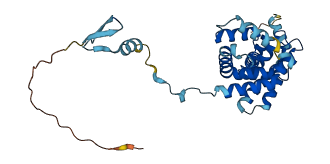Q663K1
Gene name |
yopN (lcrE, pYV0065) |
Protein name |
Outer membrane protein YopN |
Names |
LcrE, Yop4b |
Species |
Yersinia pseudotuberculosis serotype I (strain IP32953) |
KEGG Pathway |
yps:pYV0065 |
EC number |
|
Protein Class |
|

Descriptions
The autoinhibited protein was predicted that may have potential autoinhibitory elements via cis-regPred.
Autoinhibitory domains (AIDs)
Target domain |
|
Relief mechanism |
|
Assay |
cis-regPred |
Accessory elements
No accessory elements
Autoinhibited structure

Activated structure

1 structures for Q663K1
| Entry ID | Method | Resolution | Chain | Position | Source |
|---|---|---|---|---|---|
| AF-Q663K1-F1 | Predicted | AlphaFoldDB |
No variants for Q663K1
| Variant ID(s) | Position | Change | Description | Diseaes Association | Provenance |
|---|---|---|---|---|---|
| No variants for Q663K1 | |||||
No associated diseases with Q663K1
4 regional properties for Q663K1
2 GO annotations of cellular component
| Name | Definition |
|---|---|
| cell outer membrane | A lipid bilayer that forms the outermost membrane of the cell envelope; enriched in polysaccharide and protein; the outer leaflet of the membrane contains specific lipopolysaccharide structures. |
| cell surface | The external part of the cell wall and/or plasma membrane. |
No GO annotations of molecular function
| Name | Definition |
|---|---|
| No GO annotations for molecular function |
2 GO annotations of biological process
| Name | Definition |
|---|---|
| negative regulation of protein secretion | Any process that stops, prevents, or reduces the frequency, rate or extent of the controlled release of a protein from a cell. |
| protein secretion by the type III secretion system | The process in which proteins are transferred into the extracellular milieu or directly into host cells by the bacterial type III secretion system; secretion occurs in a continuous process without the distinct presence of periplasmic intermediates and does not involve proteolytic processing of secreted proteins. |
No homologous proteins in AiPD
| UniProt AC | Gene Name | Protein Name | Species | Evidence Code |
|---|---|---|---|---|
| No homologous proteins | ||||
| 10 | 20 | 30 | 40 | 50 | 60 |
| MTTLHNLSYG | NTPLHNERPE | IASSQIVNQT | LGQFRGESVQ | IVSGTLQSIA | DMAEEVTFVF |
| 70 | 80 | 90 | 100 | 110 | 120 |
| SERKELSLDK | RKLSDSQARV | SDVEEQVNQY | LSKVPELEQK | QNVSELLSLL | SNSPNISLSQ |
| 130 | 140 | 150 | 160 | 170 | 180 |
| LKAYLEGKSE | EPSEQFKMLC | GLRDALKGRP | ELAHLSHLVE | QALVSMAEEQ | GETIVLGARI |
| 190 | 200 | 210 | 220 | 230 | 240 |
| TPEAYRESQS | GVNPLQPLRD | TYRDAVMGYQ | GIYAIWSDLQ | KRFPNGDIDS | VILFLQKALS |
| 250 | 260 | 270 | 280 | 290 | |
| ADLQSQQSGS | GREKLGIVIN | DLQKLKEFGS | VSDQVKGFWQ | FFSEGKTNGV | RPF |